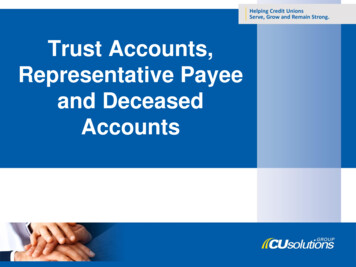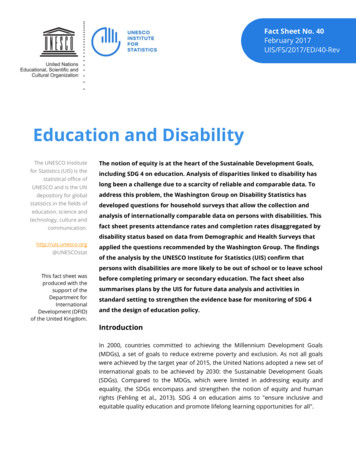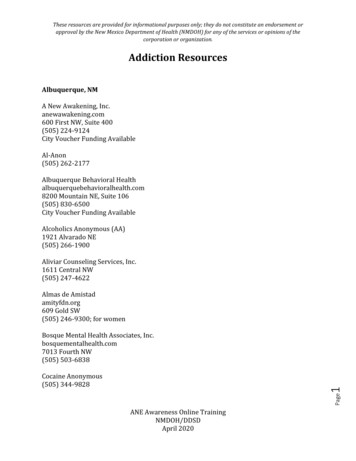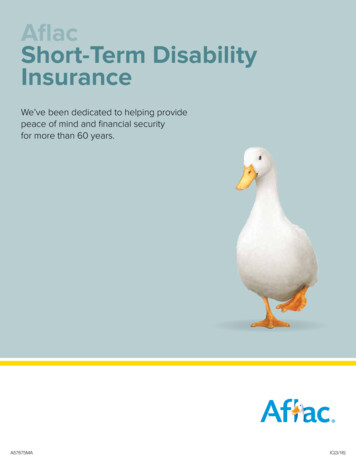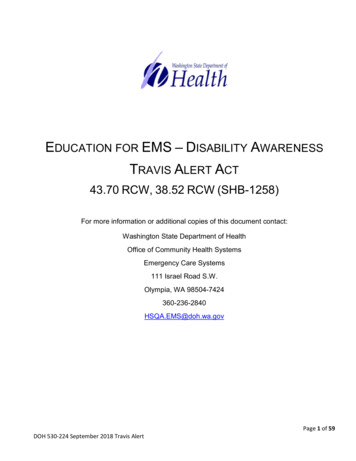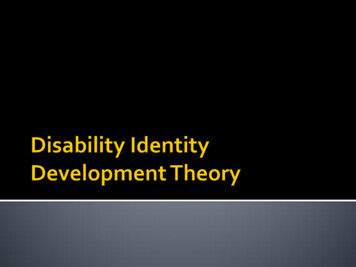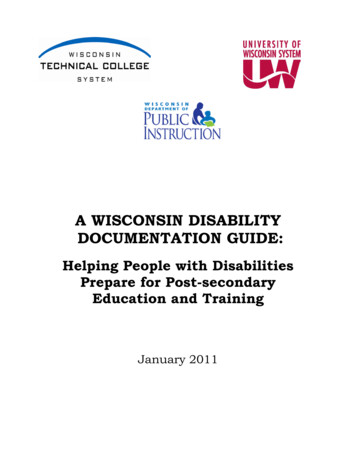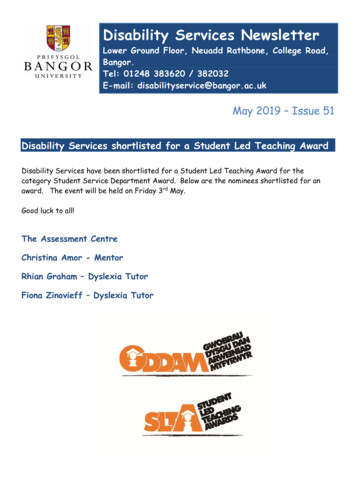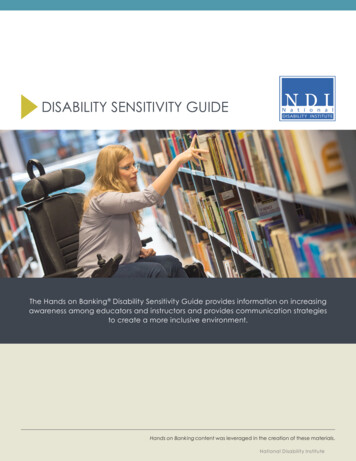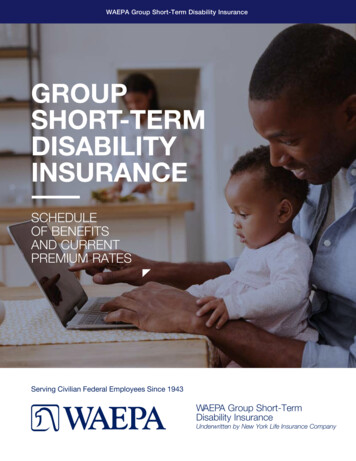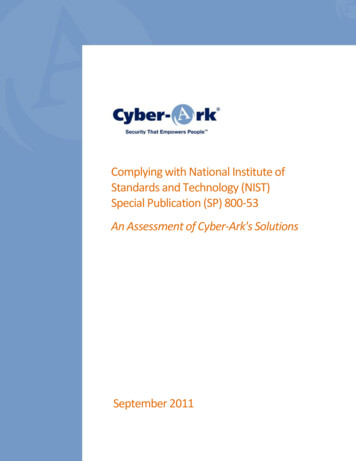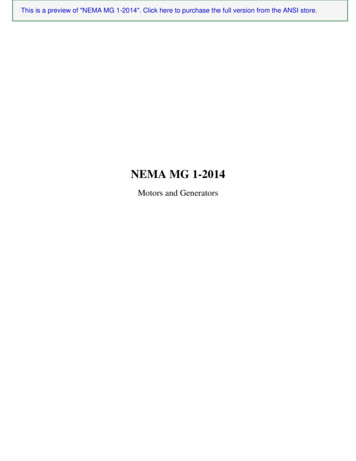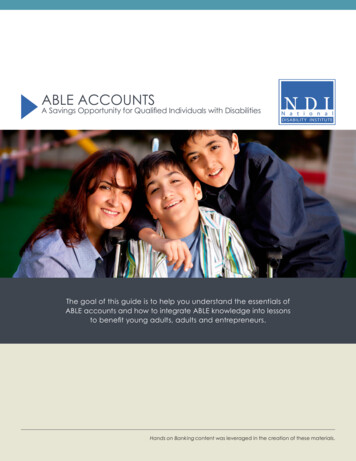
Transcription
ABLE ACCOUNTSA Savings Opportunity for Qualified Individuals with DisabilitiesThe goal of this guide is to help you understand the essentials ofABLE accounts and how to integrate ABLE knowledge into lessonsto benefit young adults, adults and entrepreneurs.Hands on Banking content was leveraged in the creation of these materials.
AcknowledgementsThis guide was developed by National Disability Institute’s Training and Technical Assistance Team.National Disability Institute is a national research and development organization with the mission todrive social impact to build a better economic future for people with disabilities and their families.National Disability Institute’s Real Economic Impact (REI) Network is comprised of an alliance oforganizations and individuals dedicated to advancing the economic empowerment of people withdisabilities. The network consists of more than 4,500 partners in all 50 states.Members include nonprofits, community tax coalitions, asset development organizations, financialeducation initiatives, corporations and private-sector businesses, federal/state/local governments andagencies, and individuals and families with disabilities. All partners join forces to embrace, promote,pursue access to and the inclusion of people with disabilities in the economic mainstream.To learn more about how to make a Real Economic Impact, join us: www.realeconomicimpact.org.For more information about the guide, please send an email to: ask@ndi-inc.org.National Disability Institute would like to thank Wells Fargo for their support of the DisabilitySupplemental Guide.2ABLE Accounts: A Savings Opportunity for Qualified Individuals with Disabilities
Financial Education Tools and ResourcesOVERVIEW OF HANDS ON BANKING Hands on Banking /El futuro en tus manos (handsonbanking.org/ndi) is a free, fun,non-commercial financial education programavailable in both English and Spanish thatteaches people, in all stages of life, about thebasics of responsible money management,including how to create a budget, save andinvest, borrow responsibly, buy a home, andestablish a small business.Hands on Banking offers flexibility in the waysinformation can be delivered in the AmericanJob Centers. The program includes individualresources and instructor guides with tools anddetailed information on content, activities, andtips on how to deliver the information.Hands on Banking can be offered as aworkshop or job seekers can access theonline program, courses and more athandsonbanking.org/ndiProgram Highlights Available online with printed instructor guides; Courses for kids, teens, young adults,and adults; Financial fundamentals for entrepreneurs; Personal finance lessons for members ofthe military, seniors, and their families; Resources for individuals, educators,non-profits, and workplace Available in English and Spanish; Designed for individual or classroom learning; Aligns with state and national educationstandards for mathematics, reading,and economics; Free, non-commercial content; Animated, interactive, and entertaining; and Easy to navigate and fun to present.National Disability Institute3
TABLE OF CONTENTSThe ABLE Act and ABLE Accounts5Case StudiesWhat is an ABLE account?5JOHN: MAKING INFORMED FINANCIALDECISIONS11WHAT SHOULD JOHN DO?11Why the need for an ABLEaccount? 6Who is eligible to be an ABLEaccount beneficiary? 7What are qualified disability expenses? 7How do you decide which stateABLE program is right for you?8OPENING AN ACCOUNT8MARY AND JUAN: SETTING FINANCIALGOALS 12WHAT SHOULD MARY AND JUAN DO?12Handout for Individuals13STEPS TO CHOOSING THE RIGHT STATEABLE PROGRAM FOR YOU13ABLE ACT: WHAT YOU NEED TO KNOW14SELECTION OF INVESTMENT OPTION 6MAINTAINING THE ACCOUNT8VALUE-ADDED PROGRAM FEATURES8Next Steps: When to Openand Make Deposits to anABLE Account84STEP ONE: SELECT THEINVESTMENT OPTION9STEP TWO: CREATE A PLAN9STEP THREE: MANAGE THE ACCOUNT9STEP FOUR: REGULARLY REVIEWACCOUNT STATEMENTS10Key Terms and Definitions101. ABLE102. ABLE ACCOUNT OWNER103. CONTRIBUTIONS104. DISTRIBUTIONS105. INVESTMENT CHOICES106. MEANS-TESTED PUBLIC BENEFITS117. QUALIFIED DISABILITY EXPENSE1111ABLE Accounts: A Savings Opportunity for Qualified Individuals with Disabilities
ABLE ACCOUNTSA Savings Opportunity for Qualified Individuals with DisabilitiesThis guide integrates content from Hands on Banking to provide additional information specific toadults with disabilities. Each of the topics and lessons provided in the Hands on Banking instructorguides are important topics for people with disabilities to learn as well.The disability community is very diverse. Some individuals with a disability may be employed, while others mayrely on public benefits as their main sources of income. Some of the public benefits they receive might havelimitations. Income, resource and savings limits often prevent individuals from enhancing their financial wellbeing and self-sufficiency as they concentrate efforts on retaining their benefits. New and existing programsare available to help people with disabilities develop skills in financial management and self-sufficiency.The goal of this supplemental guide is to help you understand the essentials of ABLE accounts and how tointegrate ABLE knowledge into lessons to benefit young adults, adults and entrepreneurs.To learn more about disability, please refer to the Disability Sensitivity Guide, a tool to increase awareness amongeducators and instructors and provide communication strategies to create a more inclusive environment.The ABLE Act and ABLE AccountsThe Achieving a Better Life Experience Act (ABLE), signed into law on December 19, 2014, opens newpathways to financial stability for millions of Americans with disabilities and their families. For the firsttime, eligible individuals with disabilities and parents raising a child with a disability may select a stateABLE program and open an ABLE savings account that will not adversely impact continued eligibility forfederal benefits, such as healthcare, Social Security, food and housing assistance. Funds contributed to anABLE account grow tax-free. ABLE offers opportunities and choices, both short- and long-term, for settingfinancial savings goals, creating and managing the funds in an ABLE account, involving family and friendsto contribute resources to the account and keeping track of expenses. Contribution to an ABLE accountand its growth represents a down payment on freedom, better health and quality of life.Hands on Banking can help current and potential ABLE account owners gain the knowledge, skills andconfidence they need to make informed financial decisions that improve their financial health and stability.What is an ABLE account?ABLE accounts are tax-advantaged savings accounts for individuals with disabilities and their families.Contributions may be made to an ABLE account by the account beneficiary, family members, friends oran employer. There are no restrictions on who can contribute to an account.There are restrictions on how much can be contributed to an ABLE account each year. The totalcontributions by all participating individuals, including family and friends, in a single tax year is 15,000.Each state sets limits as to the maximum contributions over time that can be contributed to an ABLEaccount. Most states have set the lifetime limit of contributions to an ABLE account at about 300,000.For individuals with disabilities who are recipients of Supplemental Security Income (SSI), the ABLE Act setsfurther limitations. The first 100,000 contributed to an ABLE account does not count against the SSI 2,000resource limit to remain eligible for monthly SSI payments. When an ABLE account exceeds 100,000, thebeneficiary’s SSI cash benefit is suspended until such time as the account falls back below 100,000 as aresult of distribution of some of the funds to meet financial goals and expenses. The temporary suspensionof benefits has no effect on the ability to receive or be eligible for medical assistance and other servicesand supports through Medicaid.National Disability Institute5
Since the ABLE Act was signed into law, 28 states have created ABLE programs and more states areplanning to provide ABLE accounts. To open an ABLE account, eligible individuals with disabilities andfamilies may choose which state ABLE program best meets their needs. Some state ABLE programs offertheir residents a tax deduction, up to a certain dollar amount, for their contributions to an ABLE accountin their home state, in addition to no federal taxes on income growth when funds are distributed from anABLE account for qualified disability expenses.The selection of the right ABLE program for an individual with a disability and their family should take intoaccount a number of other factors, including: fees and costs to open and maintain an account, choice of investment options to grow funds in the ABLE account with varied degrees of risk, restrictions on how often you can withdraw funds, the availability of financial education to improve the knowledge and skills to make informed financialdecisions, and other value-added elements to help an individual save, manage and grow the account savings.Why the need for an ABLE account?For parents raising a child with a disability, or a working-age adult with a disability, there are extra costsassociated with the disability that occur on a regular basis. Those extra costs could include healthcare,medications and assistive technology. Assistive technology can be as diverse as including screen readers,hearing aids, communication devices and wheelchairs, personal assistance services, transportation andhome and vehicle modifications for improved access and use. Government benefits and programs maycover some, but definitely not all of these costs. In addition, many assistance programs have set resourcelimits that can affect eligibility for assistance. The ABLE Act, for the first time, allows millions of individuals withdisabilities and their families to set money aside in a savings account managed by state ABLE programs thatwill not adversely impact resource-tested eligibility for federal government benefits. The purpose of the ABLEaccount is to supplement, not supplant, benefits provided through the federal government.For a young adult, a working-age adult or an entrepreneur with a disability, contributions to an ABLEaccount is a critical new way to help improve their health, independence and quality of life. The ABLEaccount presents important opportunities to set short and longer-term financial goals, create andmanage a budget, engage others to become contributors from a circle of support and establish a planfor spending the savings for qualified disability expenses.The account owner is the account beneficiary. There is the need for an ABLE account owner to learn skillsaround financial capability and stability. For individuals with disabilities, the opportunity presented byopening an ABLE account provides a new level of need, urgency and relevance to learn about: creating a budget, setting financial goals, the importance of saving, comparing financial products and services, identifying sources of contributions, such as income tax refunds, gifts and earnings, keeping track of expenditures and account distributions, and making informed financial decisions.6ABLE Accounts: A Savings Opportunity for Qualified Individuals with Disabilities
An ABLE account is not for every individual with disabilities and their families. To open an ABLE account,the person must meet the eligibility requirements related to age of onset of the disability and level ofdisability. Even if an individual meets the eligibility requirements, there are other factors to considerincluding, but not limited to: current debt status and need to pay down debt first, the use of other protected savings such as an Individual Development Account (IDA) where savingsare matched to help meet specific financial goals for home purchase, education or starting abusiness, and focus on short-term needs with little opportunity to grow contributions through selected investmentoptions in an ABLE account.Who is eligible to be an ABLE account beneficiary?The ABLE Act limits eligibility to individuals with significant disabilities with an age of onset of disabilitybefore turning 26 years of age. If a person meets this age criterion, and they also receive Social Securitybenefits under Supplemental Security Income (SSI) and/or Social Security Disability Insurance (SSDI),they are automatically eligible to establish an ABLE account with the state program of their choice. Ifthe person is not receiving Social Security disability benefits, but still meets the age of onset of disabilityrequirement, they can still prove eligibility by an alternative method. A licensed physician can provide aletter of certification that the person meets the Social Security definition and criteria regarding significantfunctional limitations. The person does not have to prove inability to work, nor is there any type of incomeor asset test that would limit a person’s eligibility for opening an ABLE account.The account beneficiary is allowed to have only one ABLE account and all the current state programs willallow a person to move the funds from one state ABLE program to another. To learn more about all stateABLE programs, use the interactive map on the ABLE National Resource Center website (ablenrc.org). Thewebsite, managed by National Disability Institute, provides objective, independent information to help eligibleindividuals and families make an informed choice in selecting a state ABLE program that meets their needs.A parent may open an ABLE account for an eligible son or daughter who is under the age of 18. Aneligible individual with a disability may open their own account when they are 18 or older. There is noupper age limit for an individual with a disability who meets eligibility criteria to limit their opening anaccount, as long as the onset of disability occurred before their 26th birthday.What are qualified disability expenses?Funds contributed to an ABLE account, and income growth from selected investment options, canbe distributed from an ABLE account to purchase products and services that are “qualified disabilityexpenses.” A qualified disability expense must relate to the designated beneficiary of an ABLE account.The purchase of the item or service must assist him/her in increasing or maintaining their health,independence and/or quality of life. These may include expenses related to: Education Healthcare Assistive technology Housing Financial management Personal support services Transportation Legal services Employer training and supportThe purchase of a product or service need not be for the exclusive use of the beneficiary. A van fortransportation and/or a computer for learning and communication would qualify as a disability-relatedexpense that could be paid for by an ABLE account, with no taxes paid on income generated throughinvestment of individual, family and/or friend’s contributions to the account. The interpretation of “qualifieddisability expense” is meant to be broad and comprehensive, including basic living expenses and additionaltypes of products and services that may be approved in the future by the Secretary of the Treasury.National Disability Institute7
Please note: Upon the death of the beneficiary, the state in which the beneficiary lives, and any statefrom which that beneficiary may have received Medicaid services since the creation of the ABLEaccount, may file a claim for all or a portion of the funds remaining in the account after all qualifieddisability expenses have been paid. The amount of funds cannot exceed what the state spent on thebeneficiary regarding Medicaid-related expenses, starting at the time the account was originallyestablished. This is known as the “Medicaid Payback Provision.” Some states have moved ahead tobar filing a claim of reimbursement against an ABLE account and additional states are consideringsimilar restrictions on the Medicaid Payback Provision. However, not all ABLE beneficiaries receiveMedicaid supports; therefor this provision would not apply to them. Check with your state ABLE programadministrator for further guidance on this issue.How do you decide which state ABLE program is right for you?To make an informed decision about which state ABLE program is right for you, consider the following fourareas to compare and contrast programs:OPENING AN ACCOUNT Is there a minimum contribution to open an account? Is there a fee to open an account and how much is the fee?SELECTION OF INVESTMENT OPTION Is there an investment option that matches your needs for limiting risk or focusing on long-term growth? What is the history of the rate of return of the fund? What are the fees for managing the investment option?MAINTAINING THE ACCOUNT What are the fees for managing the account? Does the program offer a free debit card to help manage distributions and purchases? Is there a limit on monthly distributions?VALUE-ADDED PROGRAM FEATURES Is there a state income tax-deduction for contributions made to the account if the owner is a state resident? Does the state offer a financial education program to help make informed decisions? Are there any other unique program elements, such as a gift platform to make it easier for others tocontribute to the account?Visit the ABLE National Resource Center website (ablenrc.org) and use the comparison tool that providesquestions and answers about state ABLE programs. The tool allows people to compare three stateprograms at a time. There are also links to each state ABLE program, enabling users to become moreinformed about program features, investment choices and costs to open and maintain an account.Next Steps: When to Open and Make Deposits to an ABLE AccountSimilar to 529 college savings plans, which are tax-advantaged savings plans designed to encouragesaving for future college costs, the earlier an account is opened, the greater the opportunity to growassets over a longer period of time with income generated from investment choices.Each individual and family will have to decide on when opening an ABLE account will be possible andmakes the most sense to meet their needs. None of the current state ABLE programs has an age limit onestablishing an ABLE account.Once the choice is made to open an ABLE account with the selected state ABLE program, there are fournext steps to consider:8ABLE Accounts: A Savings Opportunity for Qualified Individuals with Disabilities
STEP ONE: SELECT THE INVESTMENT OPTIONEach state ABLE program offers investment choices. The choices offered provide options to make a selectionbased on needs, risk tolerance and the level of fees or costs to manage the investment. The choices offeredby most states include a no-risk option of an FDIC insured savings account that will, in the current economicenvironment, produce a very limited return on investment. It is a safe investment choice that protects theaccount owner from any loss of funds contributed to the account. Other choices offered involve a mixof stocks and bonds in a mutual fund that are described as capable of modest to high yield growth withvarying degrees of risk that cannot guarantee that the funds contributed to the account will be protectedagainst any loss. Each investment choice must indicate as well the fees and costs to manage the investment.Each account owner and beneficiary must decide the primary purpose for which the ABLE accountfunds will be used. If the short-term needs occur weekly, such as extra therapy sessions for a child ortransportation to and from work for an adult, then the most appropriate choice would be a low or no riskchoice of an FDIC insured savings account. If the financial goal is more long-term, such as the purchaseof a van to have accessible transportation, one
Hands on Banking. offers flexibility in the ways information can be delivered in the American Job Centers. The program includes individual resources and instructor guides with tools and detailed information on content
